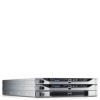Dell EqualLogic FS7500 Dell EqualLogic FS7500 - Unified block and file storage - Page 11
Test Methodology, capacity in the configuration. For each storage configuration
 |
View all Dell EqualLogic FS7500 manuals
Add to My Manuals
Save this manual to your list of manuals |
Page 11 highlights
Dell EqualLogic FS7500 - Unified block and file storage for virtual workloads Together these metrics can be used to quantify performance at the application level. Both of these performance metrics are related to each other. When the storage system reaches its performance limits, the transactional performance and latency values are often found to be in an inverse relationship. As latency increases, transactional performance decreases because of the increased time required to process each I/O. However, when the system is underutilized, transactional performance can increase without dramatically affecting latency. As a result, when assessing the performance of a storage system near saturation, it is sufficient to measure the application transactional performance at an acceptable quality of service (QoS) level that is typically defined by a maximum application transaction response time. Test Methodology Our test environment was structured to provide insight into the scalability of VMware virtual environments supporting multiple simultaneous workloads and VMware-specific virtual infrastructure operations. In this test environment, we deployed a pair of FS7500 controllers and the VM host servers with sufficient CPU, memory and network resources to avoid any bottlenecks in these subsystems. In terms of hardware, we varied only the storage configuration to understand the impact of increasing storage capacity in the configuration. For each storage configuration, we increased the workload and noted the application transaction throughputs and response times. In our test results, we focused on quantifying application transactional performance while maintaining a steady virtualization infrastructure activity as well as maintaining an acceptable application QoS. Figure 3 depicts a VMware environment with multiple virtual workloads hosted on an EqualLogic FS7500. This is the overall layout of the test environment. Page 9















